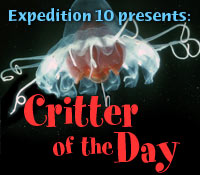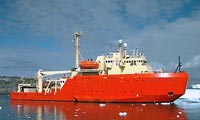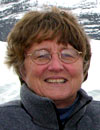|
  Today's Weather Cloudy Lat: 63 59.02 S Long: 66 55.50 W Wind: 20 KT Sea State: 3 Swell Height: 3-4 feet Baro Pressure: 997.5 mB Air Temp: 1.4°C Sea Surface Temp: 2.5°C Vis: 10 NM    Learn about the L.M. Gould in Deeper Discovery» February 22, 2006 by Kate Madin On February 18th, on the way from Punta Arenas, Chile, across the Drake Passage to Antarctica, the research team asked the master of the Gould to slow down so they could look for salps, before the cruise officially began. At midnight, Byron Pedler, Erich Horgan, Trent University graduate student Brenna McLeod, and Marine Technician Jamee Johnson, in hard hats and float-coats, lowered the bongo net over the stern. Two hundred meters (about 600 feet) of wire spun off the winch, as the bongo, two conical side-by-side nets, dropped out of sight and sank to 150 meters (about 450 feet). The weather was quiet and the ship was rocking gently, so they stayed on the aft (rear) deck, waiting for the 30 minutes of towing time to end. The team hoped to locate the salp population, and bongo net tows are a fast way to look for them. “What’s your bet?” biologist Pat Kremer asked the group. “Will there be salps, or not? We’re over the shelf here.” Another research group had reported no salps in this area last week. “I’ll say there won’t be any,” she said. The winch turned again and the net, like dual windsocks, rose out of the water on the wire; Byron and Erich pulled them on deck. Soon the contents of one net—plankton strained from the sea—were washed down into a bucket and brought into the wet lab, followed by the other. “Looks like you won your bet,” Chief Scientist Larry Madin said to Pat, “No salps in that first bucket.” Brenna brought the second bucket, expecting the same result. Then, “Salps in the second net!” somebody shouted. The net handlers poured the catch into white plastic pans, and fifteen excited people scrambled to see. The rocking ship sloshed the plankton samples back and forth, making it harder to see the transparent salps. Room lights went off, lights shone under the pans, and everyone looked. There were tiny copepods and a few krill, and then salps, about twenty of them. Salps can be single organisms or many connected in chains. “Probably just one chain,” Larry suggested, “caught in one net only.” With many researchers and few salps, how do you divide them? Scientists begin negotiating how to split up the bounty. Larry wants to measure their reproduction. Biologist Lena Von Harbou wants fresh salps, to freeze the stomachs for analysis on shore. Pat Kremer will investigate what they’re eating. Jun Nishikawa needs the salps’ muscle bands, so that he can extract the protein later. “Oh, we’re compatible!” Pat says to Jun, “We can share the same salps—I need the gut and you need the muscles; we need different parts.” For the next few hours, everyone is busy, working on this first sample. Interview
|
|||||||||||||||||||||||||||||||||||||||||||||||||||||||||||||||||||||||||||||||||||||||||||||
Mailing List | Feedback | Glossary | For Teachers | About Us | Contact
© 2010 Dive and Discover™. Dive and Discover™ is a registered trademark of Woods
Hole Oceanographic Institution

